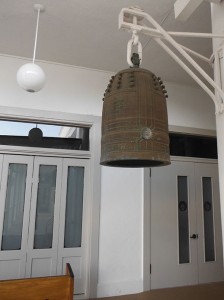Typical Sunday Schedule

The main temple hall (hondo) during a combined service on Eshinni & Kakushini Day 2013. Dharma School leads the sangha in singing “Do the Good You Know.” Photo: Ruth Tokumi
8:00 a.m.
Japanese Language Service
9:00 a.m.
Dharma School Service (late August through May). When Dharma School is in session, families with children often attend this service offered in the Annex Temple. Dharma School classes follow the service.
Meditation Beginning at 9 a.m. throughout the year, “quiet sitting” meditation is offered in the lounge before the 10 a.m. service.
10:00 a.m.
Adult English Service. See below for the sequence of a typical service. Occasionally, the Dharma School service and Adult English service merge into a combined service at 9:30 a.m. Sometimes the main service is shortened and followed by break-out Dharma sessions focused on specific topics.
11:00 a.m.
Refreshments and fellowship in the social hall—an opportunity for fellowship, asking questions, sharing insights, and simply sharing each other’s company over snacks, coffee, and tea provided by temple volunteers.
11:30 a.m.
Dharma Discussion in the lounge. An informal, facilitated discussion of themes raised in the dharma talk, applying Buddhism in everyday life, or other topics.
1:00 p.m.
Japanese Language Service
Please see the calendar to confirm service times.
A Typical Service

The ringing of the kansho, a large bell outside the main temple hall (hondo), signals the beginning of the service.
- Oshoko (Offering of Incense) We start our service with the offering of incense, This is an opportunity to show respect and gratitude for the Dharma (Buddhist teachings) and the Buddha. The fragrance purifies our minds and prepares one to listen to the Dharma. We bow in Gassho putting the hands together to signify the oneness of Buddha and all beings. It is customary to use a nenju (beads), around your hands at this offering.
- Ringing of the Bell (Kansho) A large bell is rung to signal the beginning of the service.
- Reciting the Nembutsu (Namo Amida Butsu) This is the Japanese pronunciation of the original Sanskrit phrase (Namo’mitabhaya buddhaya) meaning “I take refuge in Amida Buddha.”
- Singing of Vandana and Ti-sarana (Three Treasures) Taking refuge in the Three Treasures (Buddha, Dharma, Sangha) is the universal affirmation of all Buddhists. The first part, which is sung, is in the ancient Pali language of India. The second part, which is recited in English, elaborates on the Pali verses.
- Singing of Gathas In contrast to the traditional chanting, gathas (songs) are musical expressions of the Dharma.
- Sutra Chanting The word sutra originally meant ‘thread’ so that literally, today, a sutra is the thread that ties the teachings of the Buddha into our lives. We chant the sutras aloud, in unison, in the traditional style. Since the chants are read in Sino-Japanese, they are not chanted for comprehension. Rather, it is a symbolic gesture of listening to the Dharma and is considered a form of meditation. The Jodo Shinshu tradition is unique, in that everyone, not only the priests, is encouraged to chant together. Through participation in the chanting, the full experience of the Buddhist service is realized.
- Dharma Talk by a minister
- Singing the Nembutsu
References
- Traditions of Jodoshinshu Hongwanji-ha by Masao Kodani and Russell Hamada, Pureland Publications, 1995
- Jodo Shinshu – A Guide by the Hongwanji International Center, published by Buddhist Churches of America, 2004

